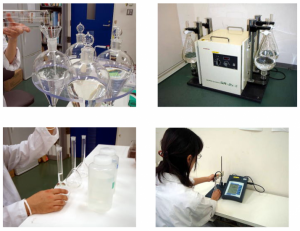変圧器の過熱による火災リスク
変圧器の過熱は、火災発生の主要なリスク要因の一つです。過熱が発生する主な原因と、それによって生じる火災リスクについて以下にまとめます。
主な火災リスクの要因
- 過負荷や短絡によるコイルの異常発熱
- 定格を超えた負荷や異常電流が流れると、コイルが異常発熱し、絶縁材料が劣化・損傷します。これが進行すると、コイルが焼損し、最悪の場合は火災事故に至ることがあります。
- 絶縁油や絶縁材料の劣化
- 油入変圧器では、絶縁油の劣化や油漏れがあると放熱能力が低下し、過熱や火災のリスクが高まります。絶縁紙などの絶縁材料の劣化や損傷も短絡や発火の原因となります。
- 接続部・端子部の接触不良
- 端子や接続部の締め付け不良や経年劣化による接触抵抗の増大は、局所的な過熱を引き起こし、火災の発生源となります。
- 放熱異常や塵埃の蓄積
- 変圧器や巻線部分に塵埃が蓄積したり、放熱が阻害されると、異常発熱から火災に至る場合があります。
火災発生時の典型的な症状
- 白煙の発生や焦げた臭い
- トランス本体や周辺機器の異常な高温
- 内部絶縁油の発火や爆発。
火災リスクの例
- 変圧器火災の主な原因として、絶縁劣化(22件)、電線の短絡(15件)、金属接触部の過熱(12件)などが多く報告されています。
- 特に受変電設備では、絶縁油の劣化や端子接続部の緩みによる発熱が火災の引き金となりやすいです。
火災リスク低減のための対策
- 適切な定格容量の選定と過負荷運転の回避
- 保護装置(温度ヒューズ、過電流遮断器など)の設置
- 定期的な点検と絶縁測定による劣化箇所の早期発見
- 正しい設置と配線工事、端子部の確実な締結
- 絶縁油の定期的な管理と交換。
まとめ
変圧器の過熱は、絶縁劣化・短絡・接触不良・放熱異常など複数の要因で火災を引き起こす重大なリスクです。定期点検や保護装置の活用、適切な運用が火災リスク低減には不可欠です。
日本環境アセスでは絶縁油の性状分析と発生ガス分析によって変圧器管理の一助を担うことができます。また絶縁紙の劣化はフルフラール分析で劣化の度合いを確認することができますのでお問合せくださいませ。
What is the fire risk caused by transformer overheating?
Fire Risk Due to Transformer Overheating
Transformer overheating is one of the major risk factors for fire outbreaks. Below is a summary of the main causes of overheating and the resulting fire risks.
1.Main Factors Contributing to Fire Risk
①Abnormal heating of coils due to overloading or short circuits;
When a transformer operates beyond its rated capacity or is subjected to abnormal currents, the coils can overheat, causing insulation materials to deteriorate or become damaged. If this progresses, the coils may burn, and in the worst case, a fire may occur.
- Deterioration of insulating oil or insulation materials;
In oil-filled transformers, degradation or leakage of insulating oil reduces cooling efficiency, increasing the risk of overheating and fire. Deterioration or damage to insulating materials such as insulating paper can also cause short circuits and fires.
③Poor contact at connection points or terminals;
Loose connections or aging at terminals increase contact resistance, causing localized overheating, which can become the source of a fire.
④Abnormal heat dissipation or accumulation of dust;
If dust accumulates on transformers or wiring joints, or if heat dissipation is obstructed, abnormal heating may occur, which can potentially lead to a fire.
2.Typical Signs When a Fire Occurs
①Emission of white smoke or a burning smell
②Abnormally high temperatures in the transformer body or surrounding equipment
③Ignition or explosion of internal insulating oil
3.Specific Examples of Fire Risk
①The main reported causes of transformer fires include insulation deterioration, short circuits in wiring, and overheating at metal contact points.
②In particular, in substation equipment, overheating due to degradation of insulating oil or loose terminal connections often triggers fires.
4.Measures to Reduce Fire Risk
①Select appropriate rated capacity and avoid overloading
②Install protective devices such as thermal fuses and overcurrent breakers
③Conduct regular inspections and insulation testing to detect deterioration early
④Ensure proper installation and wiring, and secure terminal connections
⑤Regularly manage and replace insulating oil as needed
5.Summary
Transformer overheating is a serious risk factor for fires, caused by insulation deterioration, short circuits, poor contact, and abnormal heat dissipation, among others. Regular inspections, use of protective devices, and proper operation are essential to reduce fire risk.



